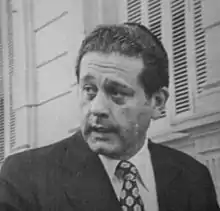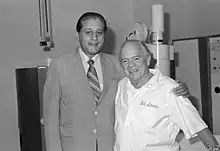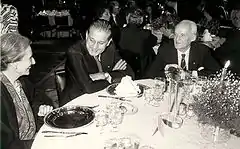René Favaloro
René Gerónimo Favaloro (July 12, 1923 – July 29, 2000) was an Argentine cardiac surgeon and educator best known for his pioneering work on coronary artery bypass surgery using the great saphenous vein.
René Favaloro | |
|---|---|
 | |
| Born | René Gerónimo Favaloro July 12, 1923 |
| Died | July 29, 2000 (aged 77) Buenos Aires, Argentina |
| Cause of death | Suicide by gunshot |
| Nationality | Argentine |
| Alma mater | National University of La Plata |
| Years active | 1949–2000 |
| Spouse(s) | María Antonia Delgado (1951–1998) |
| Parent(s) | Juan Manuel Favaloro and Geni Ida Raffaeli[1] |
| Awards | Prince Mahidol Award (1998), Order of the Sun of Peru (1973), Order of Merit of the Italian Republic (1978), Canada Gairdner International Award (1987), Golden Plate Award (1993), Konex Award (1993) |
| Signature | |
 | |
Early life
Favaloro was born in 1923 and raised in La Plata;[2] his grandparents were Sicilians.[3]
In 1936, Favaloro was admitted into the Colegio Nacional de La Plata. After graduating from high school, he was admitted to the School of Medicine at the National University of La Plata. During his third year, he began his medical residency at the Hospital Policlínico San Martín, a medical center that received the most complicated cases from much of Buenos Aires province. This residency brought him into contact with patients for the first time. He attended procedures carried out by professors José María Mainetti and Federico E. B. Christmann, from whom he learned the simplicity and standardization that he would later apply to cardiovascular surgery, one of his many great contributions to cardiovascular operating techniques. Favaloro graduated with a medical degree in 1949.[4]
He then applied for a position as a medical auxiliary, but the offer required him to enroll in the Peronist Party, which he did not accept. He moved instead to a small town named Jacinto Aráuz in La Pampa Province after being offered a job as the town's doctor; when the resident doctor died, he succeeded him and brought his brother Juan José into the clinic. He married María Antonia Delgado in 1951.[4]
Favaloro and his brother endeavored to improve the general level of health in what was then a remote region. They trained and educated the general public, teachers, and nurses and improved health-care delivery. They equipped the town with an operating room and X-ray and improved the laboratory, thereby providing essential surgical and diagnostic tools.
Thoracic surgery

Favaloro became interested in developments in cardiovascular intervention, and developed an enthusiasm for thoracic surgery. During a visit to La Plata, he met Professor Mainetti, who pointed him in the direction of the Cleveland Clinic. Although in the beginning he had doubts about leaving his profession as a rural physician, he thought that he could make a greater contribution to the community on returning from the United States. With few resources and rudimentary English, he decided to travel to Cleveland. He first worked as a resident and later as a member of the surgical team, working with Donald B. Effler, head of cardiovascular surgery, F. Mason Sones, Jr., who was in charge of the Angiography Laboratory, and William L. Proudfit, head of the Department of Cardiology.
In the beginning, the major part of his work involved valvular and congenital diseases; later on, he became interested in other areas. Every day, having hardly finished working in the operating room, Favaloro would spend hours and hours reviewing coronary angiograms and studying coronary arteries and their relation with the cardiac muscle. The laboratory of Sones, father of the coronary angiography, had the largest collection of angiograms in the United States.
In early 1967, Favaloro began to consider the possibility of using the saphenous vein in coronary surgery. He put his ideas into practice for the first time in May of that year. The basic principle was to bypass a diseased (obstructed) segment of a coronary artery in order to deliver blood flow distally. The standardization of this technique, called coronary artery bypass surgery, was the fundamental work of his career, and ensured that his prestige would transcend the limits of his country, as the procedure radically changed the treatment of coronary disease. In 1970, he published one of his best-known volumes, Surgical Treatment of Coronary Arteriosclerosis.
The Favaloro Foundation

Favaloro returned to Argentina in 1971 with the dream of developing a center of excellence similar to the Cleveland Clinic, that combined medical attention, research, and education.
Bearing that in mind, he founded the Fundación Favaloro in 1975 along with several collaborators. He took pride in having trained more than 450 residents from all over Argentina and the Americas. Favaloro contributed to raise the standard level of his specialty for the benefit of patients through innumerable courses, seminars, and conferences organized by the Fundación, among them the distinguished "Cardiology for the Consultant" (Cardiología para el Consultante), held every two years.
In 1980 Favaloro established the "Basic Investigation Laboratory" (Laboratorio de Investigación Básica), which was long financed with his own money and which, at the time, depended upon the support of the Research and Teaching Department of the Fundación Favaloro. Subsequently, it became the Institute of Research in Basic Sciences of the University Institute of Biomedical Sciences (Instituto de Investigación en Ciencias Básicas del Instituto Universitario de Ciencias Biomédicas) which in turn, was transformed into the Universidad Favaloro in August 1998.
In 1992 the nonprofit Favaloro Foundation Institute of Cardiology and Cardiovascular Surgery (Instituto de Cardiología y Cirugía Cardiovascular de la Fundación Favaloro) opened in Buenos Aires. With the motto "advanced technology in the service of medical humanism", this institute offers highly specialized services of cardiology, cardiovascular surgery and heart, lung, cardiopulmonary, liver, kidney, and bone marrow transplants, among other areas. Favaloro focused his career there, surrounded by a selected group of professionals. One of his more famous patients was boxing promoter and Luna Park arena owner Tito Lectoure, on whom Dr. Favaloro operated in 1990. It should be mentioned, however, that despite the immense costs of bypass surgery, Dr Favaloro operated daily on indigent patients, something that he felt was both a necessity and his obligation.
He kept his emphasis on disease prevention and promoting basic rules of hygiene to reduce mortality rate. With that objective, the Fundación Favaloro researches illness detection and prevention programs. Also, many publications were released by the Centro Editor de la Fundación Favaloro (Publishing Center of the Favaloro Foundation), which ceased to operate in 2000. The Favaloro Foundation is currently one of the largest institutions dedicated to cardiology in the Americas.
Death
By 2000, Argentina was submerged in an economic and political crisis, and the Favaloro Foundation was US$18 million in debt. On repeated occasions, Favaloro petitioned the Argentine government to aid the Foundation, but never received an official response, nor would the director of the PAMI public medical insurance agency, Horacio Rodríguez Larreta, agree to pay the agency's debt to the Foundation.[5] On July 29, 2000, at age 77, Favaloro fatally shot himself in the chest.[6]
Following his suicide, it was revealed that he had written a letter to Argentine President Fernando de la Rúa, that had never been read, in which he expressed being tired of "being a beggar in his own country," and asked for de la Rúa's help to raise money for the Foundation.
Although his suicide is often linked to the Foundation's financial difficulties, the letter clearly shows Favaloro felt overwhelmed by the corruption of the health system and that he could not fight against it. In the letter, he refers to himself as "Don Quixote" in his lonely battle against the giants. Aggravating this situation was that Favaloro had never recovered from the death of his wife in 1998.[4] Following her death, he had resolved to marry one of his longtime colleagues and coauthors, Diana Truden; she lived with Favaloro during his final days and was in his Palermo neighborhood house when he died by suicide.[7]
Recognitions and distinctions
Favaloro was an active member of 26 societies, corresponding of 4, and honorary of 43. He received innumerable international distinctions. The ones that stand out are: John Scott Prize 1979, granted by Philadelphia; the creation of the Chair of Cardiovascular Surgery "Dr René G. Favaloro" (Tel Aviv University, Israel, 1980); the distinction of the Fundación Conchita Rábago de Giménez Díaz (Madrid, Spain, 1982); the Teacher Prize of Argentinian Medicine (1986); the Distinguished Alumnus Award of the Cleveland Clinic Foundation (1987); The Gairdner Foundation International Award, granted by the Gairdner Foundation (Toronto, Canada, 1987); the René Leriche Prize 1989, granted by the International Surgery Society; the Gifted Teacher Award, granted by the American College of Cardiology (1992); the Golden Plate Award of the American Academy of Achievement (1993);[8] the Diamond Konex Award as the most important scientist in the last decade in his country (Argentina, 1993); and the Prince Mahidol Award, granted by His Majesty the King of Thailand (Bangkok, Thailand, 1999).
In 2007, he was named the second-greatest Argentine of all time, on the TV show El Gen Argentino.
On July 12, 2019, Google showed a Doodle celebrating what would have been his 96th birthday.[2]
Favaloro on television
Favaloro participated in educational programming for the public, distinguishing himself in the television series The Great Medical Themes, and in numerous conferences in Argentina and throughout the world on topics such as medicine, education, and modern society. He was also mentioned in the documentary movie Forks Over Knives.
Works
René Favaloro published more than three hundred works in his specialty. Owing to his passion for history, he also wrote two books about General José de San Martín.
- Surgical Treatment of Coronary Arteriosclerosis (1970)
- Recuerdos de un médico rural ("Memories of a rural doctor", 1980)
- ¿Conoce usted a San Martín? ("Do you know San Martín?", 1986)
- La Memoria de Guayaquil ("The memory of Guayaquil" 1991)
- De La Pampa a los Estados Unidos ("From La Pampa to the United States", 1993) ISBN 978-9875662902
- Don Pedro y la Educación ("Don Pedro and education", 1994)
References
- This article draws heavily on the corresponding article in the Spanish-language Wikipedia, which was accessed in the version of 12 March 2005.
- Larocca, Bruno (2013-06-13). "El caso del Dr. Favaloro" [The Case of Dr. Favaloro]. Gatopardo (in Spanish). Retrieved 2019-07-12.
- "René Favaloro's 96th Birthday". Google.com. 12 July 2019.
- "Omaggio delle Eolie al cardiochirurgo inventore del by-pass". Lisolaweb.com. March 31, 2008.
- "Así vivió y amó el corazón de un genio". Gente.com.ar.
- "Ahora el PAMI empieza el trámite para poder pagarle a la Fundación". Eldia.com.ar. August 4, 2000.
- Krauss, Clifford (August 7, 2000). "Argentina Searches Its Soul Over a Suicide". The New York Times. Retrieved 15 June 2009.
- "Diana, nunca podrás imaginar cuánto te he amado". Gente.com.ar. Archived from the original on 2012-12-02. Retrieved 2013-10-10.
- "Golden Plate Awardees of the American Academy of Achievement". www.achievement.org. American Academy of Achievement.
External links
| Wikimedia Commons has media related to René Favaloro. |
- Cardiac Surgery in the Adult: Myocardial Revascularization with Cardiopulmonary Bypass – The history section details Favaloro's role in the development of CABG.
- Favaloro Foundation (Spanish) – Spanish-language page about the investigation of the Fundación Favaloro, with a gallery of images, quotes, and an essay on Favaloro's legacy.
- Coronary Artery Bypass Surgery Thirty Years Later. Some Social Implications.
- Favaloro Foundation
- 50th Anniversary Historical Article: Surgical treatment of acute myocardial infarction. René G. Favaloro. J Am Coll Cardiol. 2000 Apr;35(5 Suppl B):18B-24B. doi: 10.1016/S0735-1097(00)80044-3. Originally published in American Journal of Cardiology, November 1971.